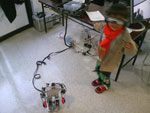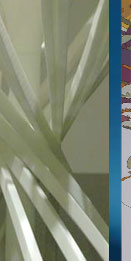エマージングテクノロジー「適応」
| 場所:ホール A | 開催時間 |
| 2009年12月17日(木) | 09:30 - 18:30 |
| 2009年12月18日(金) | 09:30 - 18:30 |
| 2009年12月19日(土) | 09:30 - 17:00 |
現実の社会に存在する課題とそれに取り込む機会について考える―今存在するものを将来存在するかもしれないものに適応させることにおいて、アートとテクノロジーの飛躍的な成果が見られます。世界が急速に進化する今、アーチストや研究者にその最前線を見せてもらいましょう。
シーグラフアジア2009のアートギャラリーとエマージングテクノロジーの展示は「適応」をテーマとしています。エマージングテクノロジーへの参加者は、最先端のデジタルメディア技術を駆使して、社会環境 に適応するためにどのように進化しているのかを 体験することができます。 下記が作品一覧となります
An Operating Method for a Bipedal Walking Robot for Entertainment

Tele-existence applications for robotic systems are becoming popular and widespread. They enable users to control a remote machine while experiencing a sense of being in the remote location. Initially, tele-existence was used for remote de-mining and mission-critical tasks in space, to avoid risking human life. Recently it has been applied in many entertainment and gaming applications, to enable a community to play together in one virtual environment and share the experience. But existing tele-existence systems require a large-scale interface, a lot of processing power, and a large space for proper operation. With this new bipedal walking robot, users can experience tele-existence in a small space, with a minimum numer of modules attached to the body and a simple, easy-to-understand controlling interface. The system configuration mainly focuses on detecting specific human actions such as foot, arm, and finger movement, and recreates synchronous motions in the bipedal robot. For example, in one scenario, each user stands in front of a visual display and remotely controls players in a small-scale soccer pitch. Physical movement of the robots is reflected in the virtual environment, and users can experience the sensations of the live game and a large audience via a head-=mounted display. This project realizes a tele-existence system not only for entertainment robotics, but also for synchronous motion in many other applications. Bipedal walking robots provide a common ground for remote users to carry out collaborative physical tasks while creating a multiple tele-existence working environment.
Yuta Sugiura Charith Lasantha Fernando Anusha Indrajith Withana Gota Kakehi Keio University, JST ERATO Daisuke Sakamoto The University of Tokyo, JST ERATO Maki Sugimoto Masahiko Inami Keio University, JST ERATO Takeo Igarashi The University of Tokyo, JST ERATO Masa Inakage Keio University


